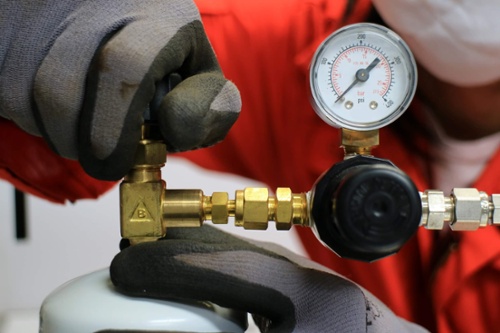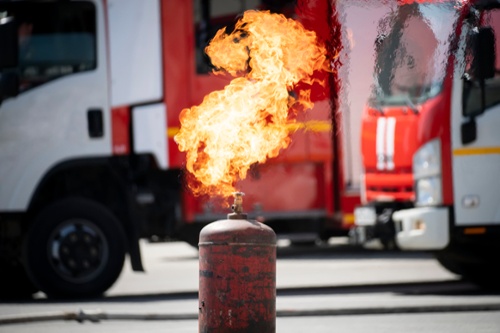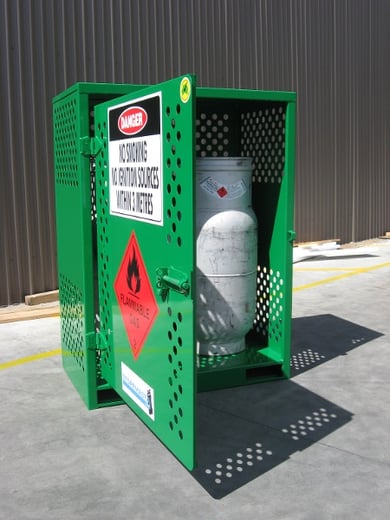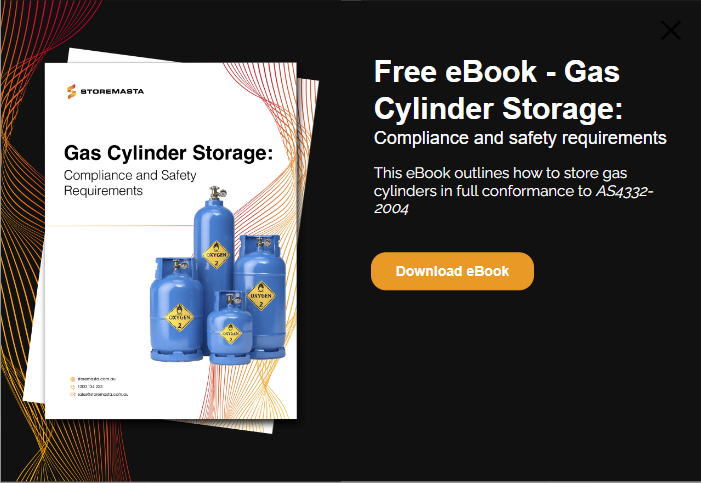Whether you’re a gas supplier or you use LPG to power your gas appliances, many workplaces across the country rely on Liquified Petroleum Gas. This gas is recognised as a Class 2.1 Flammable Gas, and therefore must be stored and located in such a way as to reduce risk. In this blog, we’ll be answering the question, ‘What are the LPG gas bottle location regulations’ by referencing the relevant Australian Standard AS 4332 - The storage and handling of gases in cylinders. We’ll also be explaining the best LPG gas bottle locations, as well as the segregation and separation requirements — along with the additional precautions for flammable gases.
Regulations for LPG Gas Bottle Locations
When we refer to regulations, we aren’t just talking about the Model Work Health and Safety Regulations. Regulations is a collective term that we use to include all current legislation, Codes of Practice and the Australian Standards.
These regulations govern the way gas cylinders must be stored in workplaces across Australia.
LPG gas bottle location regulations are essential due to the many risks associated with LP gas. Without a proper control of these risks, staff, your organisation and the wider community may be presented with a serious chemical hazard.
These LPG risks include:
- Health hazards – such as headaches, sneezing, drowsiness, seizures, asphyxiation or fatalities due to gas leaks. There is also the risk of impact damage caused by unrestrained airborne cylinders.
- Property damage – if cylinders aren’t fitted with the proper restraints, out of control gas bottles can fly around a work area, causing massive damage to equipment, vehicles and property.
- Fire and explosions – due to the flammability of this gas, ignition of LP gas can result in explosions that harm people, property and the environment

There are multiple risk to people, property and the environment when dealing with LP gas bottles in the workplace.
Where To Position LPG Gas Cylinders
Deciding where to position your gas bottles is part of your compliance and safety responsibilities.
In the Australian Standard AS 4332:2004, we can find a detailed explanation of the requirements that relate to the construction of gas bottle stores.
Outdoor Gas Bottle Storage
In Section 4.2.1, the Standard states that:
The indoor storage of gas cylinders shall be avoided wherever possible.
To effectively reduce the risks associated with LP gas, cylinders should NOT be stored indoors.

As a dense and flammable gas, LPG can spark a fire or explosion if it meets an ignition source.
This is because LPG is denser than air, so indoor storage can be particularly dangerous due to gas leaks. Leaks can occur when LPG gas cylinders have faulty valves, they have been left on or they are knocked over and damaged. Because the dense gas can quickly accumulate in low lying areas, outdoor gas cylinder stores are the preferred storage method.
Considerations When Selecting an Outdoor Gas Store Location
To reduce the risks associated with the storage of gas bottles, you should consider the following points when identifying a suitable location for your store:
- Exterior location away from pedestrians and traffic — to reduce risk of asphyxiation, health hazards and explosions.
- Ensure the location is fenced and secured from unauthorised entry.
- The gas bottle store site should be at ground level.
- The location must be away from site operations and machinery that produce artificial sources of heat, such as boilers, radiators and steam pipes. This is to reduce ignition risk.
- The site should be free from combustible materials, including rubbish and vegetation. The location should prohibit combustibles from coming within 3 metres of the gas cylinder stores.
- The area should be level or, where appropriate, suitably sloped to ensure adequate drainage — without compromising gas cylinder stability
- Outdoor LPG cylinder stores must be at least 1 metre from windows, doors, air vents and ducting.
- Entryways and exit points to cylinders stores must be kept clear at all times, in case there is an emergency situation.
IMPORTANT: If it is not possible to locate gas cylinders stores away from vehicles, you must install bollards or crash barriers to your gas bottle cage. This extra measure will effectively minimise the risk of cylinders being hit by vehicles at your site.
Choosing Compliant Gas Bottle Stores
Once you have identified, selected and prepared the site for your gas cylinder store, you can then install a suitable gas bottle cage.
Your cage should be designed and constructed to conform with the requirements of the Australian Standards. This includes the key controls of natural ventilation as well as cylinder restraints or safety straps.

Installing an outdoor gas bottle cage can reduce the impact of gas leaks and decrease the likelihood of flammable gas ignition.
Compliant gas bottle cages are available in a range of sizes to accommodate bottles ranging from 9kg to 90kg.
Features to control risk may include:
- Heavy duty construction
- Lockable doors for outdoor security
- Restraint bars and chains so that gas cylinders can be individually restrained
- Natural ventilation that complies with AS 4332:2004
- Dangerous goods and hazard signage that complies with AS 1216 and AS 1319
Segregating and Separating LPG Gas Cylinders
According to AS 4332:2004, Class 2.1 Flammable Gases like LPG must be segregated by at least 3 metres from:
- Class 2.2 (5.1) Non-Flammable, Oxidising Gases
- Class 2.3 Toxic Gases
Apart from their physical placement, safe segregation of gases can also be achieved by using screen walls.
These screen walls must be:
- Made of a non-combustible material.
- Constructed to be impervious to vapours.
- At least 1 metre taller than the highest cylinder in store.
Separation and segregation distances can vary depending on the quantity of LPG you store, as well as the other dangerous goods and hazardous chemicals used onsite.
Like to learn more about dangerous goods segregation?
Grab your free magnetic segregation chart
Remember, empty cylinders still pose a risk. Empty gas bottles still contain small amounts of flammable gas. Therefore, you’ll need separate cylinder stores for your empties, and they’ll need to be segregated properly too.
Any empty bottles must be separated from full cylinders, then stored and handled in the same way as if they were full.
Reducing Fire Risk with Flammable Gases
Cylinder stores for LPG and other flammable gases have additional precautions and requirements under the Standard.
These include:
- The possible generation of static electricity in a store containing flammable gases must be controlled in conformance with AS/NZS 1020.
- Ignition sources (including anything that could generate static electricity, like a mobile phone) must not be located in the flammable gas store.
LPG is extremely flammable so it’s especially important to think about your site operations and the types of activities and where they could possibly take place.
Are there any outdoor repairs that involve cutting or grinding tools that create sparks? Does your workplace have an outdoor spray painting area that uses aerosol cans (that generate static electricity)?
Even workers removing PPE or using fire extinguishers can create static electricity. Again, the careful consideration of the location of your LPG cylinder store is essential in maintaining compliance and safety.
Make sure that your gas bottle store location is well away from these work activities.
REMEMBER: In the event of a fire, flammable gases such as LPG will only feed the fire and increase risk to your organisation and community. The cylinders can rupture catastrophically and become projectiles. They also could be knocked over by the pressure of water from a hydrant or monitor. Take these facts into consideration when selecting the location of your LPG cylinder store.
Safe Storage for Your Workplace Gas Bottles
If you use and store LPG cylinders at your worksite and are unclear on your legal obligations, why not download our free eBook? Gas Cylinder Storage: Compliance and Safety Requirements presents the requirements of AS 4332 in clear, easy-to-read text. It also uses real world examples of workplace incidents and accidents involving gas cylinders to help you understand the fundamentals of safe gas bottle storage. Download our gas cylinder storage eBook today by clicking on the image below.
Joining the team as a Dangerous Goods Storage Consultant, Melissa Hampton became Storemasta's Marketing Manager in late 2021. With extensive knowledge and experience in chemical compliance, Melissa is responsible for leading the Marketing team and helping shape their marketing strategy. In her spare time, you can find Melissa hiking, swimming and enjoying the great outdoors in beautiful north-west Tasmania.
